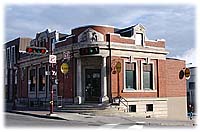The Bank of Montreal
40 Promenade du Portage

Three Philemon Wrights were the successive owners of the land on which the bank building stands. The first Philemon (1783-1821), to whom it was granted in 1806, passed it on in 1808 to his father, Philemon Wright, the founder of Hull. After the death of the elder Philemon in 1839, and further to inheritance transactions, his grandson, Philemon (1841-1874), became the new owner. He passed the property on to his niece, Janet Louisa Scott, who sold it in 1885 to her mother, Nancy Louisa Wright, wife of John Scott. The property, like many others, was subject to an annual ground rent that the building owners had to pay to the owner of the land. They did not always make the payment and, following a lawsuit initiated by Nancy Louisa Wright against the three occupants of the site, the land was released from the rights of constitut in April 1901.
The earliest occupant of this land was Dosithée C. Simon, who built a two-storey wooden house here in 1869. Olivier Latour, an Ottawa lumber dealer, transformed this house into a hotel, which he rented to William Ready in 1884 and to Gustave Chevrier in 1885. Around 1892, Eléonore Paul, widow of Alexandre Chevrier, bought the hotel, which was razed in the Great Fire of 1900.
Olivier Latour bought the vacant lot in October 1901 and sold it, five days later, to Joseph-Napoleon Fortin and Joseph-Ephraim Gravelle. In March 1902, these two businessmen also bought from Latour the nearby land on Main Street where three businesses had stood before 1900: Bertrand Florimont's restaurant, Philion H. & Co., a door and window store, and Adolphe Gratton's forge. On this land they built the Office Hotel. On May 30, 1900, shortly after the Great Fire, Fortin and Gravelle had already acquired the workshop of saddler Edmond Bertrand, located behind the Chevrier Hotel on the Bridge Street side. Bertrand, who had established his workshop in 1885, sold it in 1892 to Henry J. Borbridge, an Ottawa saddler and leather trader. Borbridge had rented it to F.-X. Laroche, also a saddler. Gravelle and Fortin built a new house on this site. Having acquired the three properties, they left part of the land vacant in hopes of finding a buyer.
The site had several advantages: it was near the Eddy Company and its nearly 2,000 employees; across the bridge, the Booth company employed many workers from Hull; it was bounded by the city's two main commercial arteries; and the public transit transfer point was right across the street, on the Commons. And so in 1907 the Bank of Montreal chose this site to open a branch. On March 30, 1907, the firm Fortin et Gravelle sold the land for $35,000. Ninety years after its founding in Montreal, the first bank in the country established a branch in Hull and hired the firm of Keefer and Weekes to construct this Beaux-Arts building, a style very much in vogue for banking institutions at the time. In September, the cost of the project was estimated at $40,000. While the building was under construction, the Bank opened a counter on May 1, 1907 in the nearby hotel. It had only two competitors: the Bank of Ottawa and the Provincial Bank of Canada. The growing population of the city provided a substantial clientele.
The first manager of the sub-branch was P. J. C. MacDonnell in 1907, followed by A. R. Paget and H. G. Fisher. Robert L. Curphey, appointed in 1919, would occupy this position for a number of years. In 1918, the branch became independent of the Ottawa branch and two years later opened its own sub-branch in the Carrière House on Victoria Street. This bank served the citizens of Hull for 63 years. During an upsurge in real estate speculation, the Bank of Montreal moved the branch to the corner of Main and Laval Streets on November 23, 1970.
The building then assumed new functions. At first, Roland Pelletier moved his Chez Roland restaurant into the former bank, but his clientele disappeared with the demolition in the area. On December 16, 1974, the National Capital Commission bought the building and rented it out. Three restaurants would occupy it in succession: l'Agostino, La Marelle and Le Steak Qui Rit. The Promenade du Portage was deserted and these establishments did not survive. Located between two businesses, the building remained vacant. When it was threatened by major alterations, the City declared it a historical monument on June 6, 1989, in Bylaw 2113. In 1990, Afif Abou Raphael bought the building from the NCC and established a convenience store, L'Escale. After the building was abandoned once again, Danielle Richer bought it in 1995 and, with Howard Graveline, opened a pawnshop that seems to have a regular clientele.
|